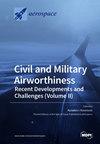CFRP Conical Grid Space Structure with Embedded Fiber Optics: Design, Manufacturing and Test
IF 2.2
3区 工程技术
Q2 ENGINEERING, AEROSPACE
引用次数: 0
Abstract
This article discloses the activity developed in the framework of the research project “GRID” aiming at the feasibility demonstration of a fiber optic sensing system (FOS), based on fiber Bragg gratings (FGB), embedded in the ribs of a conical grid structure demonstrator in composite material (CFRP), manufactured by means of dry robotic winding, liquid resin infusion and oven curing. This structure represents an optimized and highly efficient conical adapter for satellite applications that was designed under the same requirements of a conventional CFRP benchmark solution in order to evaluate possible mass savings. Specific interfaces were conceived in order to facilitate the insertion of the fiber optics in the center of helical ribs—pausing the automated deposition phase of the dry preform—and secure them to the structure. Representative grid articles were produced and tested to select the materials and evaluate the preliminary feasibility of the integrated system in conjunction with the infusion process. The proper functioning and use of the sensing system were finally proven during the various phases of the mechanical testing campaign of the demonstrator. Such a campaign included stiffness and strength evaluations and culminated with the catastrophic failure of the structure. The significant amount of data collected from several sensors embedded in the ribs and from conventional sensors glued outside the ribs helped us to better understand the structural behavior and to validate the design and analysis models. The main steps of the design, manufacturing and tests of this project are here addressed.嵌入光纤的 CFRP 锥形网格空间结构:设计、制造和测试
本文介绍了在 "GRID "研究项目框架内开展的活动,该项目旨在对光纤传感系统(FOS)进行可行性论证,该系统以光纤布拉格光栅(FGB)为基础,嵌入复合材料(CFRP)锥形网格结构演示器的肋骨中,采用干式机器人缠绕、液态树脂灌注和烘箱固化等工艺制造而成。该结构是一种用于卫星应用的优化高效锥形适配器,其设计要求与传统 CFRP 基准解决方案相同,目的是评估可能的减重效果。为了方便将光纤插入螺旋肋的中心--暂停干预成型的自动沉积阶段--并将其固定在结构上,设计了特定的接口。我们制作并测试了具有代表性的网格物品,以选择材料并评估集成系统与灌注工艺相结合的初步可行性。传感系统的正常运行和使用最终在演示器各阶段的机械测试活动中得到了验证。测试活动包括刚度和强度评估,最后以结构的灾难性失效告终。从嵌入肋骨的几个传感器和粘在肋骨外的传统传感器收集到的大量数据帮助我们更好地理解了结构行为,并验证了设计和分析模型。下面将介绍该项目的设计、制造和测试的主要步骤。
本文章由计算机程序翻译,如有差异,请以英文原文为准。
求助全文
约1分钟内获得全文
求助全文
来源期刊

Aerospace
ENGINEERING, AEROSPACE-
CiteScore
3.40
自引率
23.10%
发文量
661
审稿时长
6 weeks
期刊介绍:
Aerospace is a multidisciplinary science inviting submissions on, but not limited to, the following subject areas: aerodynamics computational fluid dynamics fluid-structure interaction flight mechanics plasmas research instrumentation test facilities environment material science structural analysis thermophysics and heat transfer thermal-structure interaction aeroacoustics optics electromagnetism and radar propulsion power generation and conversion fuels and propellants combustion multidisciplinary design optimization software engineering data analysis signal and image processing artificial intelligence aerospace vehicles'' operation, control and maintenance risk and reliability human factors human-automation interaction airline operations and management air traffic management airport design meteorology space exploration multi-physics interaction.
 求助内容:
求助内容: 应助结果提醒方式:
应助结果提醒方式:


